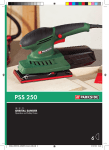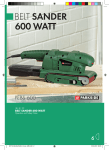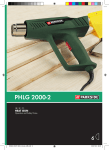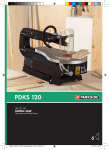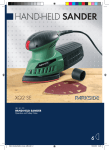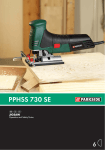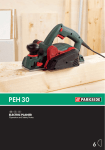Download Parkside PEBS 900 SE Sander User Manual
Transcript
PEBS 900 SE B ELT SANDER O peration and Safety Notes 6 B efore reading, unfold the page containing the illustrations and familiarise yourself with all functions of the d evice. GB / IE / CY Operation and Safety Notes Page 5 7 8 1 2 3 4 16 12 13 15 14 6 A B 9 D 14 5 C 6 E F 10 11 Table of contents Introduction Proper use.......................................................................................................................Page Features and equipment................................................................................................Page Included items................................................................................................................Page Technical information.....................................................................................................Page General safety advice for electrical power tools 1. Workplace safety......................................................................................................Page 2. Electrical safety..........................................................................................................Page 3. Personal safety...........................................................................................................Page 4. Careful handling and use of electrical power tools.................................................Page Safety advice for belt sanders.......................................................................................Page 6 6 7 7 7 8 8 8 9 Preparing for use Tensioning / changing the sanding belt........................................................................Page 10 Advice on use.................................................................................................................Page 10 Vacuum dust extraction..................................................................................................Page 10 Operation Switching on and off......................................................................................................Page 11 Selecting the correct rotational speed and sanding belt.............................................Page 11 Using the sander in a fixed mounting...........................................................................Page 12 Tips and tricks.................................................................................................................Page 12 Maintenance and cleaning. ........................................................................Page 13 Service centre.........................................................................................................Page 13 Warranty...................................................................................................................Page 13 Disposal. .....................................................................................................................Page 13 Declaration of conformity / Producer................................................Page 14 GB/IE/CY 5 Introduction The following pictograms are used in these operating instructions / on the device: n0 V~ W Read instruction manual! Safety class II Observe caution and safety notes! Wear hearing protection, dust protection mask, protective glasses and protective gloves. Caution – electric shock! Danger to life! Keep children away from electrical power tools! Explosive material! For indoor use only! Rated idle running speed Risk of loss of life by electric shock from damaged mains lead or mains plug! Voltage Dispose packaging and appliance in an environmentally-friendly way! Watts (Effective power) Belt sander PEBS 900 SE Q Introduction Please make sure you familiarise yourself fully with the way the device works before you use it for the first time and that you understand how to handle electrical power tools correctly. To help you do this please read the accompanying operating instructions. Keep these instructions in a safe place. If you pass the device on to anyone else, please ensure that you also pass on all the documentation. Q Proper use The belt sander is designed for dry sanding of large surfaces of wood, plastic, metal, plaster and painted surfaces. The device may only be used for dry sanding. Always use a sanding belt and grade of grit suitable for the particular surface you are sanding. The speed selected should also be appropriate for the material. The device is not intended for commercial use. Any other use or modification to the device shall be considered as improper use 6 GB/IE/CY and could give rise to considerable dangers. The manufacturer will not accept liability for loss or damage arising from improper use. Q Features and equipment 1 Belt speed adjuster wheel 2 Locking knob 3 ON / OFF switch 4 Toothed belt cover 5 Dust extraction spout 6 Belt adjuster screw 7 Auxiliary handle 8 Ventilation slots 9 Tensioning lever 10 Dust collection box 11 Extraction adapter Fixed mounting kit: 12 Mounting frame 13 Clamp plates 2 x 14 Screw clamps 2 x 15 Spacer plates 2 x 16 Screw Introduction / General safety advice for electrical power tools Q Included items Check that all the items and accessories are present immediately after unpacking the device: 1 Belt sander PEBS 900 SE 1 Sanding belt 1 Dust collection box 1 Extraction adapter (for external vacuum dust extraction) 1 Fixed mounting kit 1 Operating instructions Q Technical information Belt sander: Nominal voltage: Nom. power input: No-load belt speed: No-load speed: Sanding belt Protection class: Parkside PEBS 900 SE 230 V ~ 50 Hz 900 W 180 - 340 m / min n0 345 - 645 min-1 75 x 533 mm II / Noise and vibration data: Values determined in accordance with EN 60745. The sound pressure level (A-weighted) of the device is typically 86 dB (A). Uncertainty K = 3 dB. The sound level while working can exceed 100 dB (A). Wear ear protection! Total vibration, EN 60745: Vibration emission value ah,D = 2,928 m / s2 Uncertainty K < 1.5 m / s2 Warning! The vibration level given in these instructions has been measured in accordance with a standardised measurement procedure specified in EN 60745 and can be used to compare devices. Different uses of the device give rise to different vibration levels and in many cases they may exceed the values given in these instructions. It is easy to underestimate the vibration load if the electrical power tool is used regularly in particular circumstances. Note: If you wish to make an accurate assessment of the vibration loads experienced during a particular period of working, you should also take into account the intervening periods of time when the device is switched off or is running but is not actually in use. This can result in a much lower vibration load over the whole of the period of working. The PEBS 900 SE belt sander has full-wave electronics with additional control electronics, soft start with inrush current limiting. eneral safety advice for G electrical power tools Warning! Read all the safety advice and instructions! Failure to observe the safety advice and instructions may result in electric shock, fire and / or serious injury. KEEP ALL THE SAFETY ADVICE AND INSTRUCTIONS IN A SAFE PLACE FOR FUTURE REFERENCE! THE TERM “ELECTRICAL TOOL” USED IN THE SAFETY ADVICE REFERS TO ELECTRICAL TOOLS POWERED BY MAINS ELECTRICITY (BY MEANS OF A MAINS LEAD) AND ELECTRICAL TOOLS POWERED BY RECHARGEABLE BATTERIES (WITHOUT A MAINS LEAD). 1. Workplace safety a)Keep your working area clean and well lit. Untidy or poorly lit working areas can lead to accidents. b) Do not work with the device in potentially explosive environments in which there are inflammable liquids, gases or dusts. Electrical power tools create sparks, which can ignite dusts or fumes. c) Keep children and other people away while you are operating the electrical tool. Distractions can cause you to lose control of the device. GB/IE/CY 7 General safety advice for electrical power tools 2. Electrical safety To avoid danger to life from electric shock: a) T he mains plug on the device must match the mains socket. The plug must not be modified in any way. Do not use an adapter plug with devices fitted with a protective earth. Unmodified plugs and matching sockets reduce the risk of electric shock. b) Avoid touching earthed surfaces such as pipes, radiators, ovens and refrigerators with any part of your body. There is an increased risk of electric shock if your body is earthed. c)Keep the device away from rain or moisture. Water entering an electrical device increases the risk of electric shock. d) Do not use the mains lead for any purpose for which it was not intended, e.g. to carry the device, to hang up the device or to pull the mains plug out of the mains socket. Keep the mains lead away from heat, oil, sharp edges or moving parts of the device. Damaged or tangled mains leads increase the risk of electric shock. e) When working outdoors with an electrical power tool always use extension cables that are also approved for use outdoors. The use of an extension cable suitable for outdoor use reduces the risk of electric shock. f) Use a residual current device (RCD) for protection if operating the electrical power tool in a moist environment is unavoidable. The use of an RCD reduces the risk of electric shock. 3. Personal safety a) Remain alert at all times, watch what you are doing and always proceed with caution. Do not use the device if you are tired or under the influence of 8 GB/IE/CY drugs, alcohol or medication. One moment of carelessness when using the device can lead to serious injury. b) Wear personal protective equipment and always wear safety glasses. The wearing of personal protective equipment such as dust masks, non-slip safety shoes, safety helmets or ear protectors, appropriate to the type of electrical power tool used and work undertaken, reduces the risk of injury. c) Avoid unintentional operation of the device. Check that the electrical power tool is switched off before you connect it to the mains, pick it up or carry it. Accidents can happen if you carry the device with your finger on the ON / OFF switch or with the device switched on. d)Remove any setting tools or spanners before you switch the device on. A tool or spanner left attached to a rotating part of a device can lead to injury. e)Avoid placing your body in an unnatural position. Keep proper footing and balance at all times. By doing this you will be in a better position to control the device in unforeseen circumstances. f)Wear suitable clothing. Do not wear loose clothing or jewellery. Keep your hair, clothing and gloves clear of moving parts. Loose clothing, jewellery or long hair can become trapped in moving parts. g) If vacuum dust extraction and collection devices are fitted do not forget to check that they are properly connected and correctly used. The use of these devices reduces the hazard presented by dust. 4.Careful handling and use of electrical power tools a)Do not overload the device. Always use an electrical power tool that is intended for the task you are undertaking. By using the right electrical power tool for the job you will work more safely and achieve a better result. General safety advice for electrical power tools b)Do not use an electrical power tool if its switch is defective. An electrical power tool that can no longer be switched on and off is dangerous and must be repaired. c) Pull the mains plug from the socket before you make any adjustments to the device, change accessories or when the device is put away. This precaution is intended to prevent you from unintentionally starting the device. d)When not in use always ensure that electrical power tools are kept out of reach of children. Do not let anyone use the device if he or she is not familiar with it or has not read the instructions and advice. Electrical power tools are dangerous when they are used by inexperienced people. e)Look after the device carefully. Check that moving parts are working properly and move freely. Check for any parts that are broken or damaged enough to detrimentally affect the functioning of the device. Have damaged parts repaired before you use the device. Many accidents have their origins in poorly maintained electrical power tools. f)Keep cutting tools clean and sharp. Carefully maintained cutting tools with sharp cutting edges are less likely to jam and are easier to control. g)Use the electrical power tool, accessories, inserted tools etc. in accordance with these instructions and advice, and the stipulations drawn up for this particular type of device. In doing this, take into account the working conditions and the task in hand. The use of electrical power tools for purposes other than those intended can lead to dangerous situations. afety advice for S belt sanders JDanger of fire from flying sparks! Sanding metal creates flying sparks. For this reason, always make sure that nobody is placed in any danger and that there are no inflammable materials near the working area. JWhen undertaking prolonged sanding of wood, and in particular when working on materials that give rise to dusts that are hazardous to health, the sander must be connected to a suitable external dust extraction device. JEnsure that there is adequate ventilation when working on plastic, paint, varnish etc. JThe belt sander is designed for the dry sanding of large surfaces of wood, plastic, metal and plaster and painted surfaces. The device is to be used for dry sanding only. JDo not sand materials containing asbestos. Asbestos is a known carcinogen. Warning! POISONOUS DUSTS! Sanding paints containing lead, some types of wood and metal for example may give rise to hazardous or poisonous dusts and represents a risk to the health of the person operating the device and to anyone near the work area. Wear safety glasses and a dust protection mask! JSecurely support the workpiece. Use clamps or a vice to grip the workpiece firmly. This is much safer than holding it with your hand. JNever support yourself by placing your hands near or in front of the device or the workpiece surface. A slip can result in injury. JIf a dangerous situation arises, pull the mains plug immediately out of the mains socket. JAlways work with the mains lead leading away from the rear of the device. JAvoid contact with the moving sanding belt. JDo not work on moistened materials or damp surfaces. JAlways switch on the device before placing it against the workpiece. After sanding, lift the device from the workpiece before switching it off. JWhen working always hold the device securely with both hands (see Fig. D). Always keep proper footing and balance. GB/IE/CY 9 General safety advice for electrical power tools / Preparing for use JSwitch the device off and allow it to come to a complete standstill before you put it down. JWhen taking a break from your work, before carrying out any tasks on the device itself (e.g. changing the sanding belt) and when you are not using the device, always pull the mains plug out of the mains socket. Q Preparing for use QTensioning / changing the sanding belt Warning! Risk of injury! Before you carry out any work on the belt sander always pull the plug out of the mains socket. 1.Then release the tensioner for the sanding belt by moving the tensioning lever 9 fully outwards (see fig. A). The tensioner is now open and the sanding belt can be removed. 2.Next insert a new sanding belt or change the belt for one suitable for a different material or one with a different grit size. Important: The direction of the arrows on the inside of the sanding belt must agree with that on sander housing. 3.Press the tensioning lever 9 back into its initial position. Adjusting the sanding belt: jPick up the device, switch it on and turn it over. Adjust the belt tracking by turning the adjuster screw 6 until the edge of the sanding belt is flush with and runs parallel to the edge of the device (Fig. B.). Important: Always make sure that the sanding belt does not cut into the housing. Check the sanding belt regularly and if necessary re-adjust it using the adjuster screw 6 . QAdvice on use Light sanding pressure is enough: jApply light sanding pressure only. The weight of the belt sander alone is adequate to pro10 GB/IE/CY duce good sanding results. By adopting this approach you will also prolong the life of your sanding belts and obtain a smoother workpiece surface. Sanding and surfaces: The sanding output and the quality of the surface finish obtained are determined by the belt speed and the grade of grit on the sanding belt (see the section on “Selecting the correct rotational speed and sanding belt”). Sanding procedure: jWith the sander switched on, bring it into contact with the workpiece and move it forward carefully. Work in parallel and overlapping widths. Always work in the direction of the grain to avoid undesirable transverse sanding marks. After sanding always lift the device from the workpiece before switching it off. Q Vacuum dust extraction Warning! Danger of fire! There is the danger of fire when working with electrical devices that have a dustbox or can be connected to a vacuum cleaner. Under certain conditions the wood dust in the dust collection box (or in the vacuum‘s dust bag) may self-ignite, e.g. as a result of flying sparks generated when abrading metals or metal objects left in wood. This can happen particularly if the wood dust is mixed with paint residue or other chemicals and the abraded particles are hot from prolonged abrasion. Therefore you must empty the device’s dust collection box and the vacuum cleaner’s dust bag before taking a break or stopping work and always avoid overheating of the abraded particles and the device. Wear a dust mask! Dust extraction using the dust collection box: jSlide the dust collection box 10 on to the dust extraction spout 5 on the side of the device (Fig. C). Preparing for use / Operation Emptying the dust collection box: jPull the dust collection box 10 off the dust extraction spout 5 . Open the dust collection box 10 and empty it. Dust extraction using external vacuum extraction: Warning! If there is an explosive mixture of dust and air you must use a vacuum device especially intended for that purpose. Danger of fire! Do not use vacuum dust extraction (dust collection box or vacuum cleaner) when sanding metals (flying sparks). 1.Push the extraction adapter 11 on to the dust extraction spout 5 on the side of the device (see Fig. C). 2.Slide the hose of a suitable dust extraction device approved for that purpose (e.g. a workshop vacuum cleaner) on to the extraction adapter 11 . To switch on continuous operation mode: 3 , and keep it pressed, then press the locking knob 2 . jPress the ON / OFF switch To switch off continuous operation mode: 3. jPress and then release the ON / OFF switch QSelecting the correct rotational speed and sanding belt You can select the belt speed using the belt speed adjuster wheel 1 even whilst the sander is running. The optimum belt speed depends on the workpiece and the workpiece material. Always confirm the best speed by carrying out a small test. The following table lists some recommended values to help you determine the optimum speed. Material / type of work Softwood 60 Q Operation Coarse finish (Grit grade) Q Switching on and off Fine finish (Grit grade) 240 The PEBS 900 SE belt sander has full-wave electronics with additional control electronics, soft start with inrush current limiting. Preselected rotation speed high (5-6) Material / type of work Hardwood Coarse finish (Grit grade) 60 Fine finish (Grit grade) 180 When operating the belt sander you can select between intermittent or continuous operation mode. For short sanding tasks use the intermittent operation mode. For longer sanding tasks we recommend the continuous operation mode. Whilst working in your selected mode the device functions as follows: To switch on intermittent operation mode: jPress the ON / OFF switch 3 . Preselected rotation speed high (5-6) Material / type of work Chipboard Coarse finish (Grit grade) 60 Fine finish (Grit grade) 150 Preselected rotation speed high (5-6) To switch off intermittent operation mode: jRelease the ON / OFF switch 3 . GB/IE/CY 11 Operation Material / type of work Removing paint / varnish Coarse finish (Grit grade) 60 Fine finish (Grit grade) –– Preselected rotation speed high (5-6) Material / type of work Sanding varnish Coarse finish (Grit grade) 150 Fine finish (Grit grade) 320 Preselected rotation speed low (1-2) Material / type of work Rust removal Coarse finish (Grit grade) 40 Fine finish (Grit grade) 120 Preselected rotation speed medium / high (3-4) Material / type of work Plastic Coarse finish (Grit grade) 120 Fine finish (Grit grade) 240 Preselected rotation speed low / medium (2-3) Material / type of work Non-ferrous metals (e.g. aluminium) Coarse finish (Grit grade) 80 Fine finish (Grit grade) 150 Preselected rotation speed 12 GB/IE/CY medium / high (3-4) QUsing the sander in a fixed mounting The fixed mounting kit allows you to use the device for sanding vertically or horizontally by fastening it on to a flat stable surface (e.g. workbench). Sanding horizontally (see Fig. E): jPlace the belt sander on to the mounting frame 12 and guide the dust extraction spout 5 through the opening of the mounting frame 12 . Tighten the screws 16 . jPlace the two clamp plates 13 on to the holes provided on the opposite side and screw the clamp plates tight with the provided screws. jInsert the pins of the screw clamps 14 into the holes on one of the long sides of the mounting frame 12 (see Fig. E). Attach the mounting frame 12 by tightening the screw clamps 14 . Sanding vertically (see Fig. F): jInsert the pins of the screw clamps 14 into the holes on one of the short sides of the mounting frame 12 . Attach the mounting frame 12 to a flat, stable surface (e.g. workbench) by tightening the screw clamps 14 . jPlace the belt sander on to the mounting frame 12 and guide the dust extraction spout 5 through the opening of the mounting frame 12 . Tighten the screws 16 . jPlace the two clamp plates 13 on to the holes provided on the opposite side and screw the clamp plates tight with the provided screws. Q Tips and tricks jNever use the same sanding belt to sand wood and metal. jWorn or ripped sanding belts can damage the workpiece. Change sanding belts at the appropriate time. jKeep the sanding belt properly tensioned so that it does not hang down too much and become unusable due to nicks, creases etc. Maintenance and cleaning / Service centre / Warranty / Disposal Q Maintenance and cleaning Warning! Risk of injury! Before you carry out any work on the belt sander always pull the mains plug out of the mains socket. The belt sander is designed to be maintenance-free. jClean the device frequently. This should be done immediately after you have finished using it. jUse a dry cloth to clean the device - never use petrol, solvents or cleaners that attack plastic. jAlways keep the ventilation slots clear. jRemove any adhering dust with a narrow paint brush. Q Service centre J Warning! Have your device repaired only by qualified specialist personnel using original manufacturer parts only. This will ensure that your device remains safe to use. J Warning! If the plug or mains lead needs to be replaced, always have the replacement carried out by the manufacturer or its service centre. This will ensure that your device remains safe to use. Q Warranty This appliance is guaranteed for 3 years from the date of purchase. It has been carefully produced and meti-culously checked before delivery. Please keep your receipt as proof of purchase. Contact your service centre by telephone in case of questions pertaining to the warranty. Your goods can be transmitted free of cost only in this manner. This warranty applies only to the initial purchaser and is non-transferable. The appliance is intended solely for private, not commercial, use. If this product has been subjected to improper or inappropriate handling, abuse, or interventions not carried out by one of our authorised sales and service outlets, the warranty will be considered void. This warranty does not affect your statutory rights. GB DES UK LTD Tel.: 0871 5000 700 (£ 0,10 / minute) e-mail: [email protected] IE Kompernaß Service Ireland Tel.:1850 930 412 (0,082 €/Min.) * Standard call rates apply. Mobile operators may vary. e-mail: [email protected] Q Disposal The packaging is wholly composed of environmentally-friendly materials that can be disposed of at a local recycling centre. Do not dispose of electrical power tools with the household rubbish! In accordance with European Directive 2002 / 96 / EC (covering waste electrical and electronic equipment) and its transposition into national legislation, worn out electrical power tools must be collected separately and taken for environmentally compatible recycling. Contact your local refuse disposal authority for more details of how to dispose of your worn out electrical devices. The warranty covers only material or manufacturing faults, not normal wear or damage to fragile parts such as switches or rechargeable batteries. GB/IE/CY 13 Declaration of conformity / Producer Q Declaration Producer of conformity / We, Kompernaß GmbH, Burgstr. 21, D-44867 Bochum, Germany, hereby declare that this product complies with the following EU directives: Machinery Directive (98 / 37 / EC) EU Low Voltage Directive (2006 / 95 / EC): EN 60745-1, EN 60745-2-4 Electromagnetic Compatibility (2004 / 108 / EC): EN 50366, EN 55014-1, EN 61000-3-2, EN 61000-3-3, EN 55014-2 Type / Description of product: Parkside belt sander PEBS 900 SE Bochum, 31.10.2009 Hans Kompernaß - Managing Director - We reserve the right to make technical modifications in the course of further development. 14 GB/IE/CY I AN 37835 K ompernaSS GmbH B urgstraße 21 D -44867 Bochum © by ORFGEN Marketing Last Information Update: 10 / 2009 Ident.-No.: PEBS 900 SE102009-6 6














